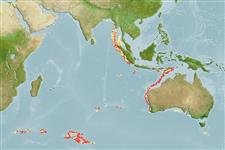>
Gadiformes (Cods) >
Macrouridae (Grenadiers or rattails)
Etymology: Nezumia: A Japanese word that means "mouse" .
More on authors: Iwamoto & Williams.
Environment: milieu / climate zone / depth range / distribution range
Ökologie
seewasser bathydemersal; tiefenbereich 568 - 886 m (Ref. 91203). Deep-water
Eastern Indian Ocean: Western Australia and off Indonesia.
Size / Gewicht / Alter
Maturity: Lm ? range ? - ? cm
Max length : 24.5 cm TL Männchen/unbestimmt; (Ref. 35909)
Rückenflossenstacheln (insgesamt) : 2; Afterflossenstacheln: 0. pelvic fin rays 9; underside of head almost completely naked, pocketed with prominent pores; body scales covered with moderately long, needlelike spinules in mostly parallel rows, spinules overlap posterior scale margin slightly; 6.5-7.5 scale rows below origin of second dorsal fin; lower jaw teeth in broad, short band; abdomen light bluish, dorsally on trunk dirty straw-colored or tawny; first dorsal fin dusky overall; anterior dermal window of light organ between pelvic fin bases. Snout protruding, angular.
A benthic species found on the continental slope (Ref. 75154).
Life cycle and mating behavior
Maturities | Fortpflanzung | Spawnings | Egg(s) | Fecundities | Larven
Iwamoto, T. and A. Williams, 1999. Grenadiers (Pisces, Gadiformes) from the continental slope of western and northwestern Australia. Proc. Calif. Acad. Sci. 51(3):105-243. (Ref. 35909)
IUCN Rote Liste Status (Ref. 130435)
Bedrohung für Menschen
Harmless
Nutzung durch Menschen
Tools
Zusatzinformationen
Download XML
Internet Quellen
Estimates based on models
Preferred temperature (Ref.
123201): 1.7 - 8.3, mean 2.9 °C (based on 16 cells).
Phylogenetic diversity index (Ref.
82804): PD
50 = 0.5000 [Uniqueness, from 0.5 = low to 2.0 = high].
Bayesian length-weight: a=0.00219 (0.00111 - 0.00431), b=3.20 (3.03 - 3.37), in cm total length, based on LWR estimates for this (Sub)family-body shape (Ref.
93245).
Trophic level (Ref.
69278): 3.3 ±0.1 se; based on size and trophs of closest relatives
Widerstandsfähigkeit (Ref.
120179): mittel, Verdopplung der Population dauert 1,4 - 4,4 Jahre. (Preliminary K or Fecundity.).
Fishing Vulnerability (Ref.
59153): Low vulnerability (15 of 100).
